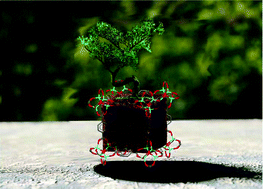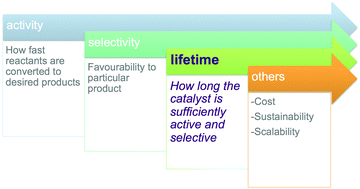Themed collection Green Chemistry 2017 Emerging Investigators

Green Chemistry Emerging Investigators 2017 themed issue
Green Chemistry Emerging Investigators 2017 themed issue.

Green Chem., 2017,19, 2707-2710
https://doi.org/10.1039/C7GC90063E
Green chemistry and polymers made from sulfur
Polysulfide polymers prepared from elemental sulfur have found increasing use in applications that benefit the environment.

Green Chem., 2017,19, 2748-2761
https://doi.org/10.1039/C7GC00014F
Metal–organic frameworks meet scalable and sustainable synthesis
Inspired by recent commercialisation of metal–organic frameworks, this review highlights challenges and recent advances in developing scalable and sustainable metal–organic synthesis.

Green Chem., 2017,19, 2729-2747
https://doi.org/10.1039/C7GC01078H
Intensification studies of heterogeneous catalysts: probing and overcoming catalyst deactivation during liquid phase operation
In addition to high levels of activity and selectivity, promising heterogeneous catalysts must also possess sufficient levels of stability. This tutorial review covers the topic of heterogeneous catalyst deactivation during liquid phase operation.

Green Chem., 2017,19, 2711-2728
https://doi.org/10.1039/C7GC00163K
Switchable (pH-driven) aqueous biphasic systems formed by ionic liquids as integrated production–separation platforms
Reversible production–separation systems can be prepared by varying the speciation of at least one of their components.

Green Chem., 2017,19, 2768-2773
https://doi.org/10.1039/C7GC00157F
Selective hydrogenation of N-heterocyclic compounds using Ru nanocatalysts in ionic liquids
N-Heterocyclic compounds have been tested in the selective hydrogenation catalysed by small 1–3 nm sized Ru nanoparticles (NPs) embedded in various imidazolium based ionic liquids (ILs).

Green Chem., 2017,19, 2762-2767
https://doi.org/10.1039/C7GC00513J
The carbon nanotube formation parameter space: data mining and mechanistic understanding for efficient resource use
Data-mining of the carbon nanotube growth parameters informed strategies to reduce energy and resource consumption for chemical vapor deposition processes.

Green Chem., 2017,19, 3787-3800
https://doi.org/10.1039/C7GC01421J
Amphiphilic dipyridinium-phosphotungstate as an efficient and recyclable catalyst for triphasic fatty ester epoxidation and oxidative cleavage with hydrogen peroxide
A novel amphiphilic dipyridinium peroxophosphotungstate ion pair achieved remarkable selectivity and recyclability towards epoxidation and oxidative cleavage of fatty acids and esters.

Green Chem., 2017,19, 2855-2862
https://doi.org/10.1039/C7GC00298J
Bifunctional Lewis and Brønsted acidic zeolites permit the continuous production of bio-renewable furanic ethers
Bifunctional Sn- and Al-containing BEA zeolites, prepared by solid state incorporation, allow furanic ethers to be produced continuously at high (>80%) levels of selectivity.

Green Chem., 2017,19, 2846-2854
https://doi.org/10.1039/C7GC00160F
Is water a suitable solvent for the catalytic amination of alcohols?
The catalytic aqueous-phase amination of biogenic alcohols with solid catalysts is reported for future development of renewable amine value-added chains.

Green Chem., 2017,19, 2839-2845
https://doi.org/10.1039/C7GC00422B
Informing rational design of graphene oxide through surface chemistry manipulations: properties governing electrochemical and biological activities
The electrochemical and biological activities are synergistically driven by the physicochemical properties of graphene oxide and reduced graphene oxide.

Green Chem., 2017,19, 2826-2838
https://doi.org/10.1039/C7GC00159B
Phenolic acetals from lignins of varying compositions via iron(III) triflate catalysed depolymerisation
A small lignin library was used to study the relationship between the lignin structure and the aromatic product yields during acidolysis.

Green Chem., 2017,19, 2774-2782
https://doi.org/10.1039/C7GC00195A
Developing hierarchically porous MnOx/NC hybrid nanorods for oxygen reduction and evolution catalysis
A facile and green synthesis gives hierarchically porous MnOx/nitrogen-doped-carbon nanorods for excellent bifunctional oxygen catalysis.

Green Chem., 2017,19, 2793-2797
https://doi.org/10.1039/C7GC00147A
Biomass-derived monomers for performance-differentiated fiber reinforced polymer composites
Nearly all polymer resins used to manufacture critically important fiber reinforced polymer (FRP) composites are petroleum sourced.

Green Chem., 2017,19, 2812-2825
https://doi.org/10.1039/C7GC00320J
Base-catalysed, one-step mechanochemical conversion of chitin and shrimp shells into low molecular weight chitosan
A facile, solid-state mechanochemical method was developed for the synthesis of low molecular weight chitosan (LMWC) in one step from chitin and crude shrimp shell powders, in which chitin undergoes simultaneous deacetylation and depolymerisation in the presence of a base catalyst under mechanical milling.

Green Chem., 2017,19, 2783-2792
https://doi.org/10.1039/C7GC00089H
Biphasic extraction of mechanocatalytically-depolymerized lignin from water-soluble wood and its catalytic downstream processing
During saccharification of water-soluble wood, a dual 2-MeTHF/water solvent system enables extraction of low molecular weight lignin fragments.

Green Chem., 2017,19, 2803-2811
https://doi.org/10.1039/C6GC03191A
Controlling reactivity through liquid assisted grinding: the curious case of mechanochemical fluorination
We have identified an example of a mechanochemically milled organic reaction where liquid-assisted grinding controls the selectivity, such a phenomenon has not been reported/observed before.

Green Chem., 2017,19, 2798-2802
https://doi.org/10.1039/C6GC03139K